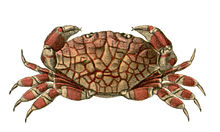| Lophozozymus pulchellus | |
|---|---|
 | |
| Scientific classification | |
| Domain: | Eukaryota |
| Kingdom: | Animalia |
| Phylum: | Arthropoda |
| Class: | Malacostraca |
| Order: | Decapoda |
| Suborder: | Pleocyemata |
| Infraorder: | Brachyura |
| Family: | Xanthidae |
| Genus: | Lophozozymus |
| Species: | L. pulchellus |
| Binomial name | |
| Lophozozymus pulchellus A. Milne-Edwards, 1867 | |
Lophozozymus pulchellus is a species of crab in the family Xanthidae. [1]